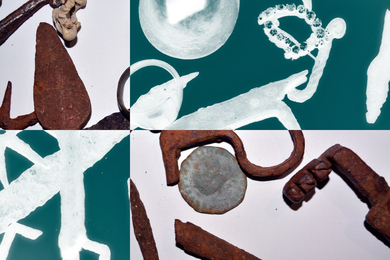"Visions of the future from a particular moment always tell more about that moment than they ever tell about the future," William J. Mitchell, professor of architecture and of media arts and sciences, told his listeners at a lunchtime gallery talk on Nov. 1.
That observation didn't hold him back, however, from predicting a future in which GPS-equipped cars bid against one another, eBay style, but with no involvement from their human drivers, for scarce available downtown parking spaces; or a future in which the entire outer skins of "intelligent buildings" naturally become "display spaces"--potentially works of public art, or maybe just a free-for-all of Jumbotrons as in New York's Times Square.
The audience gathered in an exhibition space that recalls the opening sequence of "2001: A Space Odyssey," Stanley Kubrick's 1968 film that had its own vision of the future, from the perspective of the year that included political assassinations, widespread civil disturbance and the "summer of love."
But Mitchell reminded his listeners that 1968 was also the year that ARPAnet began--the forerunner of the Internet, which has given rise to a "ubiquitously networked world."
The gallery talk was at the List Center for the Visual Arts, home through April 2007 to "Sensorium: Embodied Experience, Technology and Contemporary Art," an exhibition inquiring into "the relationship between the body and electronic technology," which has "reached a new techno-sensual comfort zone in the early 21st century," according to the catalogue.
Mitchell is known for his work on how digital technology is creating not only "intelligent buildings" but intelligent cities--entities analogous to sensing human beings.
Both in his exhibition catalogue essay, "Networked Eyes," and in his gallery talk, he discussed the humble camera cell phone as the forward edge of this trend. Cameras have been connected to telephones for years--Mitchell's essay is illustrated with a photo of a demonstration of desktop videophones at the 1964 New York World's Fair. But such phones "put the eyes of the network in the wrong places," Mitchell wrote. "A representation of the visible world constructed from the viewpoints of desk accessories just wasn't that interesting."
It is the addition of mobility to the camera-plus-telephone combo that has turned out to be critical. "In the process of evolving a global digital sensorium, the camera-phone mutation--which shifted electronic eyes from desktops to the palms of our hand--has turned out to be a winner."
Whatever ubiquitous networking will do to cities, it will not make them disappear, Mitchell said. "There's no sign whatever that cities are going away," he observed. What he called "adjacency," or "spatial precedence," remains a scarce commodity in architecture and urban design, and digital technology is leading to changes in the way this commodity is allocated.
Considering the essential functions of a bookstore, and how Amazon carries them out differently from, say, the Harvard Book Store, he observed that digital technology has "mobilized" the advertising and browsing functions, has "concentrated" the book storage functions into large depots with good access to air connections, and has "decentralized" back-office functions, which telecommuting knowledge workers can now do from anywhere.
Digital technology also gives rise to an increasing phenomenon of "pre-experience"--before you see the painting on the museum wall, you've seen it on the museum's web site; before you visit the city you've explored it virtually using online mapping technologies.
This sets up a new tension, Mitchell said, between expectations and reality. "This is transformative in your experience of a city," he said, comparing earlier eras when one would build a mental map of a place by experience, block by block. "What does your mental map mean in an era of Mapquest?"
A version of this article appeared in MIT Tech Talk on November 8, 2006 (download PDF).






